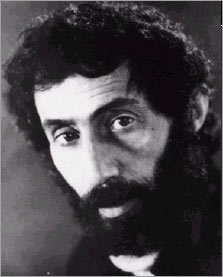Sohrab Sepehri facts for kids
Quick facts for kids
Sohrab Sepehri
|
|
|---|---|
 |
|
| Born | October 7, 1928 |
| Died | April 21, 1980 (aged 51) Tehran, Iran
|
| Resting place | Mashhad-e Ardahal, Kashan, Iran |
| Occupation | Persian poet and painter |
| Signature | |
 |
|
Sohrab Sepehri (Persian: سهراب سپهری; October 7, 1928 – April 21, 1980) was a very important Iranian poet and painter. He is seen as one of the five most famous Iranian poets who wrote modern poetry. Other famous poets like Nima Youshij, Ahmad Shamlou, Mehdi Akhavan-Sales, and Forough Farrokhzad also wrote modern poetry. Sohrab Sepehri's poems have been put into many languages, including English, French, Spanish, Italian, and Lithuanian.
Contents
Sohrab Sepehri's Life Story
Sohrab was born in Kashan, Iran on October 7, 1928. He grew up in a family that loved art and poetry. His father worked in a post office and enjoyed art very much. His mother also loved poetry and art. When Sohrab was a child, his father became very ill and passed away in 1941.
Sohrab finished his early schooling in Kashan. In 1943, he moved to Tehran to study at a teachers' college. He worked as a teacher for a few years. After that, he became a student at the Faculty of Fine Arts at the University of Tehran. He graduated with high honors.
After finishing his studies, he worked for an oil company, but he left after only eight months. Soon, he published his first book of poems called "The Death of Color." His second book, "Life Sleeps," came out after that. Sohrab Sepehri was very good at fine arts. His paintings were shown in many art shows in Europe. His paintings often show nature. One of his paintings was sold in Tehran in 2018. He is known as one of Iran's best modern painters.
Sadly, Sohrab went to England for medical treatment. But he had to come back to Tehran because his illness got worse. He passed away in Pars Hospital in Tehran on April 28, 1980. He was buried in Kashan. Sohrab never got married. Many people who love art often visit his grave.

Sepehri traveled to many countries in Europe. In Paris, he took a course in lithography at the school of Fine Arts. Lithography is a special way of printing using a stone or metal plate. However, he stopped getting money to help him study, so he needed to find work. Sometimes, he worked hanging from tall buildings to wash windows.
Sohrab Sepehri's Poetry Style
Sohrab Sepehri knew a lot about Buddhism, a way of life from Asia, and also about Western traditions. He mixed ideas from the East with art styles from the West. This created a new kind of poetry in Persian literature. He had his own special way of writing poems. He used short sentences instead of long ones, which was different from how Persian poetry had been written for hundreds of years. For him, new ways of writing helped him share his thoughts and feelings.
In one of his works called 'Footsteps of Water' or ‘The Water’s Footfall,’ Sepehri talks about himself, his family, and his ideas in a poetic way. This poem is like a life story and has two parts: an inner part and an outer part. The inner part of the poem is about understanding God through the beauty of nature. Sepehri explains that he does not just follow religious rules without thinking.
In most of his poems, Sepehri created a new kind of writing. He used romanticism, which means focusing on feelings and nature, and symbolism, which means using objects to represent ideas. The beauty of his poems comes from his love for nature and his use of gentle and simple words. Abdolali Dastgheib, a well-known writer and critic, believes that Sepehri's poetry became even better after books like ‘The Water’s Footfall,’ ‘Traveller,’ and ‘The Green Volume’ were published.
His poems often use personification, where objects are given human qualities, or symbols. For example, in his poem "Let's not Spoil the Water," he talks about water. Water is a very important part of life that people must keep clean. He used a special way of symbolism in these poems. It made the objects seem to talk to the reader, instead of just describing them.
Sepehri's poetry is full of kindness and care for human values. He also found a new way to paint called Texture. This was a painting method that other painters did not know about for a long time. He often created his art in quiet places, like "Ghariyeh Chenar" and the deserts near Kashan. His poetry has been put into many languages. These include English, French, Spanish, German, Italian, Swedish, Arabic, Turkish, Dutch, and Russian. An English version of some of his poems was published in 2003.
Important Dates in Sohrab Sepehri's Life
- Born in 1928 in Kashan, Iran.
- He held a painting show in Tehran in 1944.
- He published his first poetry book, "The Death of Color," in 1951. A few other books followed that same year.
- He earned his Bachelor of Arts degree in painting from Honar-haye Ziba University, Tehran, in 1953.
- He translated some Japanese poetry into Persian and published it in a magazine called Sokhan in 1955.
- He traveled to Ghazvin and went to the Paris Fine Arts School for lithography in 1957.
- He traveled to Tokyo to study lithography and wood carving more deeply in 1960.
- He published three poetry books in 1960.
- On his way back to Iran from Japan, he visited India in 1961. There, he learned about the ideas of Buddhism.
- He traveled to India again and visited many cities in 1964.
- He traveled to Pakistan and Afghanistan in 1964.
- He traveled to Europe in 1966. He visited countries like Germany, England, France, Spain, the Netherlands, Italy, and Austria.
- He published some long poems after he returned to Iran in 1966.
- He held another painting show in Tehran in 1967.
- He published another poetry book in 1967.
- He traveled to Greece and Egypt in 1974.
- He published his final, big book called Hasht Ketab (lit. The Eight Books) in 1976. This book was a collection of almost all his published poems in one volume.
- He got Leukemia, a type of cancer, and traveled to England for treatment in 1978.
- Sadly, his efforts to fight cancer did not work. He returned to Iran and passed away in Pars Hospital in Tehran on Monday, April 21, 1980. He was buried in Mashhad Ardehal, Kashan, Isfahan province, Iran.
Sohrab Sepehri's Works
- Hasht Ketab (Eight Books) 1976
- The Death of Color 1951
- The Life of Dreams 1953
- Us nil, us a look (This book was not published until 1977)
- Downpour of Sunshine 1958
- East of Sorrow 1961
- The Wayfarer 1966
- The Green Space 1967 (A poem from this book, "The Oasis of Now" (1965), was translated by Kazim Ali with Mohammad Jafar Mahallati and published in 2013.)
See also
 In Spanish: Sohrab Sepehri para niños
In Spanish: Sohrab Sepehri para niños
- Iranian art
- Islamic art
- Islamic calligraphy
- List of Iranian artists

